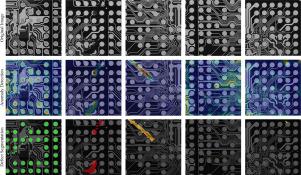Towards efficient wafer visual inspection: Exploring novel lightweight approaches for anomaly detection and defect segmentation
IF 4.3
引用次数: 0
Abstract
The rapid advancement of both wafer manufacturing and AI technologies is reshaping the semiconductor industry. As chip features become smaller and more intricate, the variety and complexity of defects continue to grow, making defect detection increasingly challenging. Meanwhile, AI has made significant strides in unsupervised anomaly detection and supervised defect segmentation, yet its application to wafer inspection remains underexplored. This work bridges these fields by investigating cutting-edge lightweight AI techniques for automated inspection of current generation of silicon wafers. Our study leverages a newly curated dataset comprising 1,055 images of 300 mm wafers, annotated with 6,861 defect labels across seven distinct types, along with PASS/FAIL decisions. From a data-centric perspective, we introduce a novel unsupervised dataset-splitting approach to ensure balanced representation of defect classes and image features. Using the DINO-ViT-S/8 model for feature extraction, our method achieves 96% coverage while maintaining the target 20% test ratio for both individual defects and PASS/FAIL classification. From a model-centric perspective, we benchmark several recent methods for unsupervised anomaly detection and supervised defect segmentation. For unsupervised anomaly detection, EfficientAD obtains the best performance for both pixel-level and image-wise metrics, with F1-scores of 75.14% and 82.35%, respectively. For supervised defect segmentation, UPerNet-Swin achieves the highest performance, with a pixel-level mDice of 47.90 and a mask-level F1-score of 57.45. To facilitate deployment in high-throughput conditions, we conduct a comparative analysis of computational efficiency. Finally, we explore a dual-stage output fusion approach that integrates the best-performing unsupervised anomaly detection and supervised segmentation models to refine PASS/FAIL decisions by incorporating defect severity.

迈向高效晶圆视觉检测:探索新的轻量级异常检测和缺陷分割方法
晶圆制造和人工智能技术的快速发展正在重塑半导体产业。随着芯片特征越来越小、越来越复杂,缺陷的种类和复杂性也在不断增加,使得缺陷检测越来越具有挑战性。与此同时,人工智能在无监督异常检测和监督缺陷分割方面取得了重大进展,但其在晶圆检测中的应用仍未得到充分探索。这项工作通过研究用于当前一代硅片自动检测的尖端轻量级人工智能技术,将这些领域联系起来。我们的研究利用了一个新整理的数据集,其中包括1055张300毫米晶圆的图像,标注了7种不同类型的6861个缺陷标签,以及通过/不通过的决定。从以数据为中心的角度来看,我们引入了一种新的无监督数据集分割方法,以确保缺陷类和图像特征的平衡表示。使用dino - viti - s /8模型进行特征提取,我们的方法实现了96%的覆盖率,同时对单个缺陷和PASS/FAIL分类保持20%的目标测试比率。从以模型为中心的角度来看,我们对几种最新的无监督异常检测和监督缺陷分割方法进行了基准测试。对于无监督异常检测,EfficientAD在像素级和图像级指标上都获得了最佳性能,f1得分分别为75.14%和82.35%。对于监督缺陷分割,supernet - swin达到了最高的性能,像素级的mdevice为47.90,掩码级的F1-score为57.45。为了便于在高吞吐量条件下部署,我们对计算效率进行了比较分析。最后,我们探索了一种双阶段输出融合方法,该方法集成了性能最好的无监督异常检测和监督分割模型,通过结合缺陷严重程度来改进PASS/FAIL决策。
本文章由计算机程序翻译,如有差异,请以英文原文为准。
求助全文
约1分钟内获得全文
求助全文

 求助内容:
求助内容: 应助结果提醒方式:
应助结果提醒方式:


